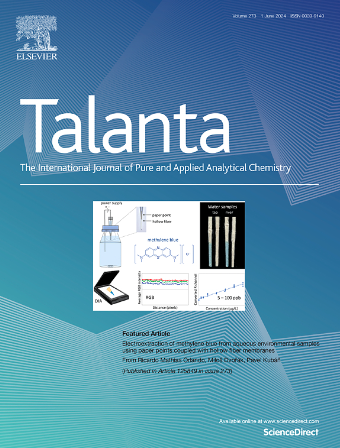Inspired by enzyme-linked aptamer assay: Polydopamine coating-enhanced colorimetric-photothermal lateral flow assay for detection of enrofloxacin
IF 5.6
1区 化学
Q1 CHEMISTRY, ANALYTICAL
引用次数: 0
Abstract
Developing rapid and portable tests for enrofloxacin (ENR) residues is critical to ensuring food safety. At present, aptamer-based lateral flow analysis (Apt-LFA) has received extensive attention due to low cost and user friendliness. The study presents a novel LFA for the sensitive detection of ENR, using bovine serum albumin-enrofloxacin (BSA-ENR) conjugates as the competitor. Based on the competitive binding between ENRapt and both ENR and BSA-ENR, we developed an indirect competitive enzyme-linked aptamer assay (icELAA). Leveraging the above findings, an Apt-LFA for rapid ENR analysis was designed. Polydopamine was in situ grown on plasmonic Au nanorods to serve as signal probes (Au NRs/PDA), with improved colorimetric and photothermal responses and enhanced structural stability. The dual-readout Apt-LFA achieved a visual limit of detection of 5 ng/mL, about 20 times more sensitive than conventional Au nanoparticles-based LFA. Notably, the Au NRs/PDA-LFA simplifies the assay process of HRP-based icELAA, presenting a flexible and promising tool for extensive food safety assessment.

求助全文
约1分钟内获得全文
求助全文
来源期刊

Talanta
化学-分析化学
CiteScore
12.30
自引率
4.90%
发文量
861
审稿时长
29 days
期刊介绍:
Talanta provides a forum for the publication of original research papers, short communications, and critical reviews in all branches of pure and applied analytical chemistry. Papers are evaluated based on established guidelines, including the fundamental nature of the study, scientific novelty, substantial improvement or advantage over existing technology or methods, and demonstrated analytical applicability. Original research papers on fundamental studies, and on novel sensor and instrumentation developments, are encouraged. Novel or improved applications in areas such as clinical and biological chemistry, environmental analysis, geochemistry, materials science and engineering, and analytical platforms for omics development are welcome.
Analytical performance of methods should be determined, including interference and matrix effects, and methods should be validated by comparison with a standard method, or analysis of a certified reference material. Simple spiking recoveries may not be sufficient. The developed method should especially comprise information on selectivity, sensitivity, detection limits, accuracy, and reliability. However, applying official validation or robustness studies to a routine method or technique does not necessarily constitute novelty. Proper statistical treatment of the data should be provided. Relevant literature should be cited, including related publications by the authors, and authors should discuss how their proposed methodology compares with previously reported methods.
 求助内容:
求助内容: 应助结果提醒方式:
应助结果提醒方式:


